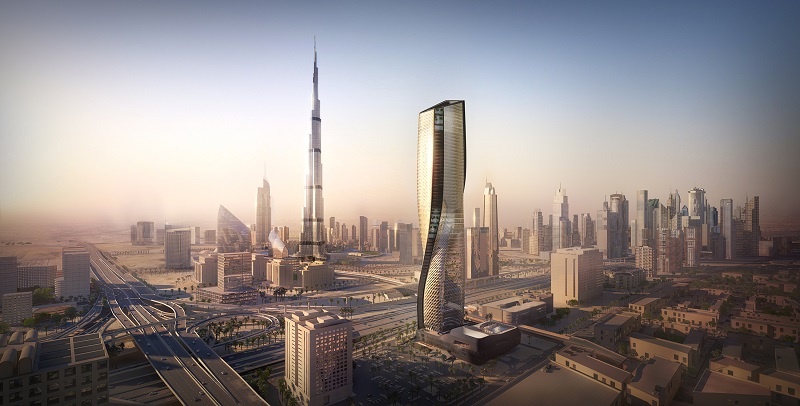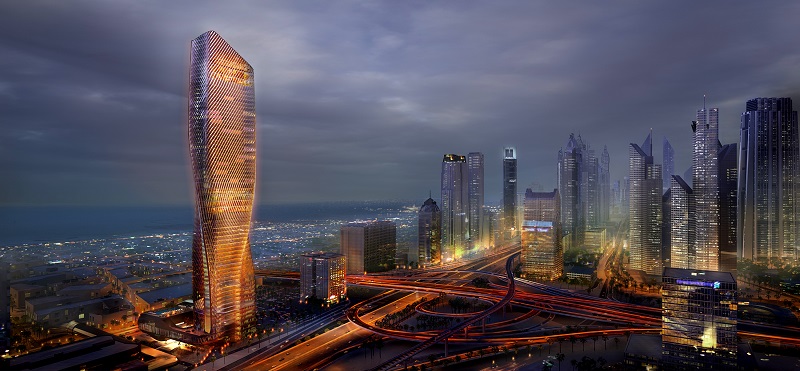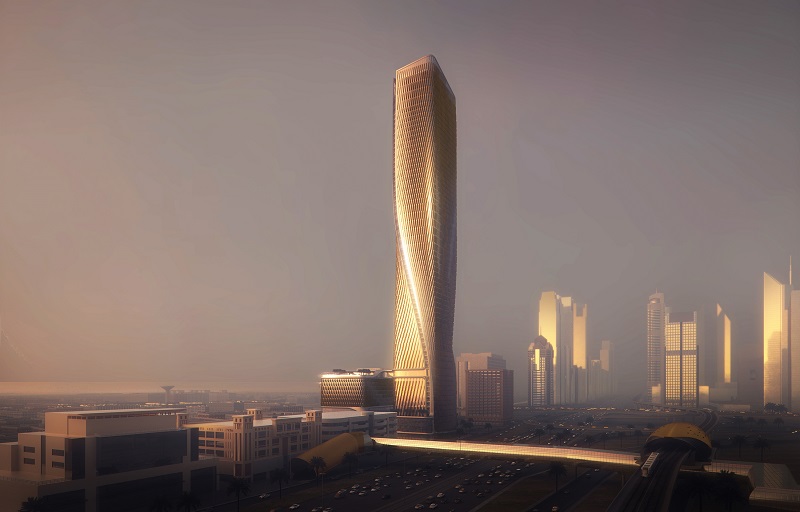Wasl Tower
In October 2017, UNStudio and Werner Sobek unveiled their design for a new Dubai skyscraper with what has been described as the 'world's tallest ceramic facade'.
Wasl Tower will be located in an exceptional, central position along Sheikh Zayed Road, the main thoroughfare that connects the Emirates north to south - and directly opposite the world's tallest building, the Burj Khalifa.
The 300 m-high skyscraper is designed with a twisted, asymmetric shape and will be clad in glazed clay tiles that interlace to form sweeping curves. According to the designers, their concept adopts the principle of 'counterpose', a form in classical sculpture which involves one foot taking more weight and the shoulders and hips being naturally twisted off-axis.
The facade will be illuminated at night in a programmed rhythm, giving the impression that the building is breathing. Developed by Arup, the lights will be positioned behind the fin-shaped tiles and will be powered through solar panels installed on the roof of a nearby car park. The carefully-angled tiles will also provide shade whilst allowing natural light to filter into the building.
The mixed-use building will be operated by hotel group Mandarin Oriental and, in addition to a hotel, will contain offices, private apartments, and public spaces. An open seam will run the full height of the tower, forming a 'vertical boulevard' of stacked outdoor balconies and greenery, with an infinity pool at the top.
Construction began in 2016, and is scheduled to complete in 2020.
Content and images courtesy of UNStudio.
[edit] Find out more
[edit] Related articles on Designing Buildings Wiki
Featured articles and news
International Electrician Day, 10 June 2025
Celebrating the role of electrical engineers from André-Marie Amperè, today and for the future.
New guide for clients launched at Houses of Parliament
'There has never been a more important time for clients to step up and ...ask the right questions'
The impact of recycled slate tiles
Innovation across the decades.
EPC changes for existing buildings
Changes and their context as the new RdSAP methodology comes into use from 15 June.
Skills England publishes Sector skills needs assessments
Priority areas relating to the built environment highlighted and described in brief.
BSRIA HVAC Market Watch - May 2025 Edition
Heat Pump Market Outlook: Policy, Performance & Refrigerant Trends for 2025–2028.
Committing to EDI in construction with CIOB
Built Environment professional bodies deepen commitment to EDI with two new signatories: CIAT and CICES.
Government Grenfell progress report at a glance
Line by line recomendation overview, with links to more details.
An engaging and lively review of his professional life.
Sustainable heating for listed buildings
A problem that needs to be approached intelligently.
50th Golden anniversary ECA Edmundson apprentice award
Deadline for entries has been extended to Friday 27 June, so don't miss out!
CIAT at the London Festival of Architecture
Designing for Everyone: Breaking Barriers in Inclusive Architecture.
Mixed reactions to apprenticeship and skills reform 2025
A 'welcome shift' for some and a 'backwards step' for others.
Licensing construction in the UK
As the latest report and proposal to licence builders reaches Parliament.
Building Safety Alliance golden thread guidance
Extensive excel checklist of information with guidance document freely accessible.
Fair Payment Code and other payment initiatives
For fair and late payments, need to work together to add value.
Pre-planning delivery programmes and delay penalties
Proposed for housebuilders in government reform: Speeding Up Build Out.
High street health: converting a building for healthcare uses
The benefits of health centres acting as new anchor sites in the high street.



























